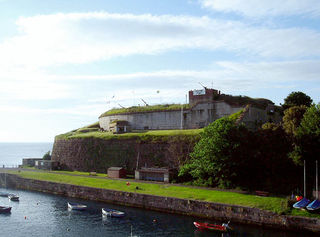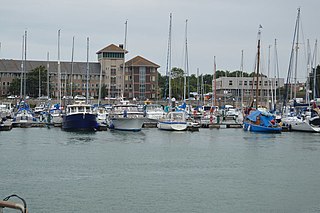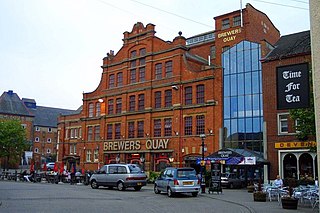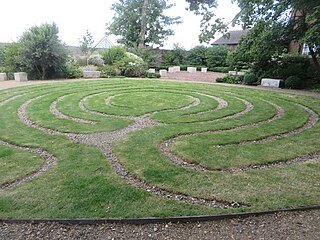
The Block House was an old fort in the town of Melcombe, in Weymouth, Dorset, southern England. There are no visible remains today.

The Block House was an old fort in the town of Melcombe, in Weymouth, Dorset, southern England. There are no visible remains today.
The fort was mentioned in texts from 1568 and 1617, and so dates from before that time. [1] It was probably built by the town of Melcombe, before 1571, when Melcome and Weymouth became a single borough.
When built, the fort was 45 feet (14 m) square, and was made of stone. [1] It likely stood opposite a passage from Maiden Street to St Mary's Street, which today is likely Blockhouse Lane. [1] At the time, it was built on the site of "Charloote Row" ( 50°36′37″N2°27′12″W / 50.610229°N 2.453200°W Coordinates: 50°36′37″N2°27′12″W / 50.610229°N 2.453200°W ), which is now a terrace and listed building. [2] [3] There were embrasures for eight guns, although only five were ever fitted. [3] During the reign of Elizabeth I, a gentleman called Richard Smith was given the office of gunner, known as vi bellator, for life. [3] This suggests some royal funding for the fort, although it was likely built by the town of Melcombe, rather than the Crown itself. [2]

The Isle of Portland is a tied island, 4 miles (6 km) long by 1.7 miles (2.7 km) wide, in the English Channel. Portland is 5 miles (8 km) south of the resort of Weymouth, forming the southernmost point of the county of Dorset, England. A barrier beach called Chesil Beach joins it to the mainland. The A354 road passes down the Portland end of the beach and then over the Fleet Lagoon by bridge to the mainland. Portland and Weymouth together form the borough of Weymouth and Portland. The population of Portland is 12,400.

Weymouth and Portland was a local government district and borough in Dorset, England. It consisted of the resort of Weymouth and the Isle of Portland, and includes the areas of Wyke Regis, Preston, Melcombe Regis, Upwey, Broadwey, Southill, Nottington, Westham, Radipole, Chiswell, Castletown, Fortuneswell, Weston, Southwell and Easton; the latter six being on the Isle of Portland.

Nothe Fort is a fort in Weymouth, Dorset, England, situated at the end of the Nothe Peninsula, which juts eastwards from the town of Weymouth, and Weymouth Harbour, into the sea to the north of the ex-military Portland Harbour. The fort is located next to Nothe Gardens.

Sandsfoot Castle, also known historically as Weymouth Castle, is an artillery fort constructed by Henry VIII near Weymouth, Dorset. It formed part of the King's Device programme to protect against invasion from France and the Holy Roman Empire, and defended the Weymouth Bay anchorage. The stone castle had an octagonal gun platform, linked to a residential blockhouse, and was completed by 1542 at a cost of £3,887. Earthwork defences were built around the landward side of the castle, probably in 1623. Sandsfoot saw service during the English Civil War, when it was held by Parliament and Royalists in turn during the conflict. It survived the interregnum but, following Charles II's restoration to the throne, the fortress was withdrawn from military use in 1665.

South Dorset is a constituency represented in the House of Commons of the UK Parliament since 2010 by Richard Drax, a Conservative. The constituency was created as a consequence of the Redistribution of Seats Act 1885, although the area covered has changed since then.
Weymouth and Melcombe Regis was a borough in England. It was formed by a charter of Elizabeth I, amalgamating the towns of Weymouth and Melcombe Regis in 1571.
Radipole is a part of the district of Weymouth and Portland in the county of Dorset, England.

Weymouth Marina occupies most of the inner backwater of Weymouth Harbour, Dorset, England. The marina was refurbished to accommodate more vessels in the 1990s, and today houses hundreds of pleasure cruisers, fishing boats, yachts, dinghies and speedboats. Access to the marina is via a lifting road bridge across the harbour between Weymouth and Melcombe Regis.

The Weymouth Harbour Tramway is a disused heavy rail line running entirely on the streets of Weymouth, Dorset, England from a junction to the north of Weymouth station to Weymouth Quay station at Weymouth Harbour. Built in 1865, it was last used for timetabled British Rail services in 1987. Its last-ever services were special trains on 1 April 1995 and 2 May 1999.

The Battles of Weymouth, and the associated Crabchurch Conspiracy occurred in 1645, during the English Civil War, when several royalist plotters within the twin towns of Weymouth and Melcombe on the Dorset coast conspired to deliver the ports back into the control of Charles I.

Weymouth is a seaside town in Dorset, England, situated on a sheltered bay at the mouth of the River Wey on the English Channel coast. The town is 11 kilometres (7 mi) south of Dorchester and 8 kilometres (5 mi) north of the Isle of Portland. Weymouth has a metropolitan population of 71,611 (2018). The town is the third largest settlement in Dorset after Bournemouth and Poole.

Weymouth Museum is a museum in Weymouth, Dorset, England. It is located within Brewers Quay on the south side of Hope Square near Weymouth Harbour. The museum currently uses temporary space to display a small part of its collection prior to carrying out planned expansion and redevelopment plans.
Melcombe Priory was a Dominican priory in Melcombe Regis, Dorset, England.

Nothe Gardens is a public garden, located in Weymouth, Dorset, England. Positioned on the Nothe Peninsula overlooking both Weymouth and Portland harbours, the informal gardens are often acclaimed to be the most beautiful the borough has to offer.
Cotton Fort was a small fortification in Melcombe, now part of the town of Weymouth, Dorset. No trace of the fort exists today.

Weymouth Peace Garden is garden dedicated to peace in the seaside town of Weymouth in Dorset, southern England.
Robert Stone Comben CBE JP, was a British Liberal Party politician who gave over 40 years service to local government in Dorset.

Weymouth Town Bridge is a lifting bascule bridge in Weymouth, Dorset, England, connecting the formerly separate boroughs of Weymouth and Melcombe Regis. The bridge can be lifted to allow boats access to the inner backwater of Weymouth Harbour, known as Weymouth Marina. The bridge, opened in 1930, is the sixth to have been built across the harbour since 1597 and has been Grade II Listed since 1997. Today, the hydraulically-operated bridge is raised every two hours, 363 days of the year. It remains one of Weymouth's most iconic features.

St John's Church is an active Church of England church in Weymouth, Dorset, England. It was built in 1850-54 by Philip Dodson to the designs of Talbot Bury. The chosen site, at the northern end of Weymouth Esplanade, had to be purchased from the Johnstone estate. It was consecrated on 19 October 1854. The transepts were added around 1868, while the entire church was restored in 1883.

Weymouth Old Town Hall is a former town hall at Weymouth, Dorset, England. The building, which was built with Portland stone in the 1770s, has been Grade II listed since 1953. The bell turret is believed to date from the 17th century. Since 2009, the hall has been operated for community use by the Guardians of the Old Town Hall.